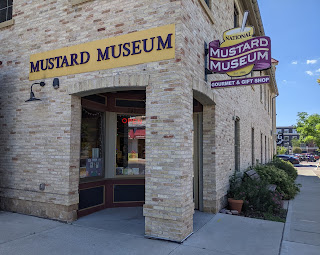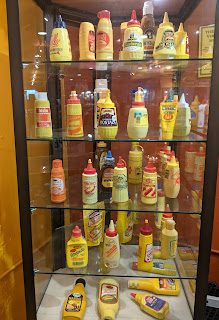
After Steven and I visited Madison's beautiful statehouse and Olbrich Botanical Gardens, a stop out in the country at the Holy Wisdom Monastery sounded like a great change of pace. When the Benedictine sisters moved from Iowa to the Madison Diocese in 1953, they initially opened a girls' high school and then a retreat and conference center. The Saint Benedict Center welcomed Christians and people of all faiths and, in 1998, the monastic community extended its membership to all Christian women. The center was located on a hill overlooking Lake Mendota and Madison's skyline.
The opportunity to explore the nature trails that surrounded the monastery was what had brought us to Holy Wisdom. It was a perfect place for quiet reflection.
The Mary and Elizabeth Hermitages were classified as retreats.
When the Benedictine sisters moved to the property, the original 40 acres had consisted of farmland that had been cleared in the early 1900s. In 1996, the sisters and numerous volunteers began a ten-year project of restoring 95 acres of farmland to the prairie. A 10,000-year-old glacial lake was dredged and restored to its original size.
From the trails, we had great views of the North Mendota Wildlife Area.
One of the trails took us through the Oak Woodlands.
Another place of quietude was The Pines.
Never had we seen a bench like this in any park.
A pamphlet identified the deep orange wildflowers as Butterfly Weed which bloomed in the Midwest from mid-June until August.
With the sisters' commitment to the environment and caring for the earth, they decided to replace Benedict House with a building that would earn the highest LEED rating from the US Green Building Council. When the monastery was finished in 2009, it was certified under LEED-NC with 63 of 69 points, a world record for new construction projects.
The Gathering Area and Assembly Room or chapel was illuminated by a dramatic skylight. The north-facing windows ensured that the entire room received ample natural light during the day. I read that highly efficient fluorescent light fixtures tucked into the soffits reflected light off the upper walls and ceiling.
The engineered bamboo floor was twice as durable as oak.
The four triangles cut into one wall were also illuminated by the skylights and their shape reflected the sisters' logo.
After these bells were removed from the old monastery, they were refurbished and installed in the new Bell Tower to call people to prayer. The monastery had been a pleasant interlude from the city's crowds.
I don't think we could possibly have found a more dramatic change from the monastery to the National Mustard Museum in nearby Middleton!

In case you were wondering why the museum was in the Madison suburb of Middleton, here's the short story! Barry Levenson, a fanatical Boston Red Sox fan and native of Worcester, Massachusetts, grew up rooting for his hometown baseball team. Even after moving to Wisconsin in 1970 to become the Assistant Attorney General for the state, Levenson continued to be an avowed Red Sox fan. You can therefore perhaps understand as he watched in despair as his hometown baseball team lost a chance yet again to win the World Series in 1986.
Levenson was depressed beyond words that his team had "snatched defeat from the jaws of victory" as they had been so, so close to winning. I could almost imagine his despair as the Sox hadn't won the World Series since 1918.
After the loss, Levenson walked the aisles of an all-night grocery store looking for the 'meaning of life.' Deciding he needed a hobby to distract himself from his 'Red Sox angst,' he figured he'd collect something and that was, as you probably figured out by now, all things mustard. In 1991, he gave up the law and opened up what is now the world's largest collection of mustards and mustard memorabilia.
One of my favorite images:
Barry Levenson aka Mona Mustard!
For a very humorous take on Mona Mustard: The Other Da Vinci Masterpiece, I encourage you to click on the image to make it easier to read!
In the gift shop upstairs, I would take a guess and say they had a couple of hundred mustard varieties. Two of our four children are mustard aficionados so I texted photos of oodles of varieties, asking them to choose their favorite. Steven was also delighted with his Authentic Stadium Mustard and has been using it ever since on his hot dogs. I, however, am a woman of simple tastes and like good ol' French's mustard - no fancy condiments for me, thanks!
Even if you're not a mustard fan, I think you'll be amused by these photos.
For a 'mere' $1,000 donation to the National Mustard Museum, this Wisconsin license plate could be yours!
A sign said visitors could play the Mustard Ring Toss for a buck and that the money should be put in the donation box on the honor system because mustard lovers are always honest!
This was just a partial collection of mustards from around the world!
And just some from my adopted state of Colorado:
Reinhold Schlegelmilch established a porcelain factory in 1869 in Suhl in what was then Prussia, now Germany. As R.S. porcelain exemplified the finest in European tableware, its delicate vases, plates, and mustard pots became famous throughout the world.
Kansan collectors C.L. and Lavonne Shirley donated their extensive collection of the earliest days of Schlegelmilch production to the museum in 2012.

What a hoot the entire museum and shop was - just the quirky type of place Steven and I liked to discover on this long road trip through America's heartland!
Steven told me that night that there had been a Canadiana section at the museum that I had somehow missed. I was pretty bummed as I always try and stay tuned for "Canadian content" when we travel! I called up the museum and ended up speaking to Barry Levenson, the owner, founder, and model for the Mona Lisa mustard lookalike, who kindly said he'd take the following photos for me. My sincere thanks to Barry for going the extra mile for me.
Looking back on it, our day in Madison was really quite strange with a tour of the capitol building, the Olbrich Botanical Gardens, the Holy Wisdom Monastery, the National Mustard Museum, and finally, the First Unitarian Society of Madison that had been designed by Frank Lloyd Wright in 1949. The largest Unitarian Universalist congregation in North America commissioned Wright to design its Meeting House as he was a church member and son of two of its founders.
I read that the church building had been recognized as one of the most innovative examples of church architecture and, in 1960, was designated as one of 17 buildings to be retained as an example of Wright's contribution to American culture. "The dramatic result has been variously interpreted as the prow of a ship, a plow cutting through the prairie, and hands folded in prayer."
Before the standard 50-year cutoff for historic buildings, the Meeting House was placed on the National Register of Historic Places in 1973. It was designated a National Historic Landmark by the National Park Service in 2004.
Though the church had been closed since the beginning of the pandemic, members had lovingly adorned exterior pillars with colorful handknitted coverings.
If we ever return to Madison, I would love to see the Meeting House's interior to see more of Wright's genius.
Next post: Milwaukee's Annunciation Greek Orthodox Church, Pabst beer, The Fonze, and other Milwaukee trivia!
Posted on the last day of July 2021, again from Gulf Shores, Alabama, where we're enjoying catching up on reading and finalizing details for our upcoming trip to Europe in September in between hours spent at the pool and at the beach. Not a bad life, I hasten to add!!














































No comments:
Post a Comment